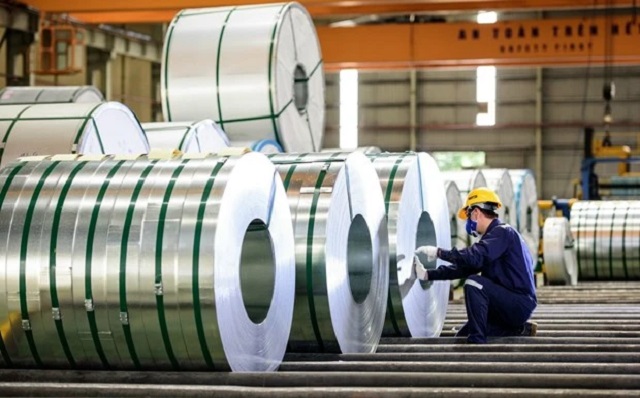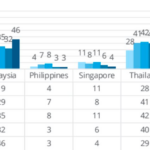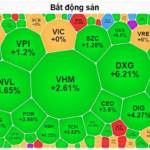
Steel companies meet market demand to boost exports. (Photo: PV/Vietnam+)
|
Vietnam’s steel industry currently ranks 14th in the world in terms of exports, with more than 30 markets importing Vietnamese steel. Around 25-30% of Vietnam’s steel exports go to the European Union (EU), accounting for about 16% of the steel market share in the EU every year.
However, as of the beginning of 2024, steel exports to the EU will have to comply with new regulations, including safeguard measures for imported steel and preparation for the application of the Carbon Border Adjustment Mechanism (CBAM), posing major challenges for the steel industry to overcome when exporting to this market.
New regulations
In 2023, Vietnam exported over 2.5 million tons of steel to the EU, almost doubling compared to 2022. Since the Vietnam-EU Free Trade Agreement (EVFTA) came into effect (from August 2020), the Vietnamese steel market has continuously expanded its market share, and the EU is now one of the major export markets for the Vietnamese steel industry.
Dr. Nguyen Van Hoi, Director of the Institute for Strategic Policy Research (Ministry of Industry and Trade), believes that the steel industry’s contribution to export activities has contributed to Vietnam’s trade surplus despite the difficulties of global trade in recent years.
“In the context of difficulties in import-export activities in general, the EU market still maintains a trade surplus despite a decrease in global import-export activities as well as country-level activities, with positive contributions from commodities such as iron and steel,” he said.
Although achieving high export results in the past year, from mid-2023 and especially from 2024 onwards, steel exports to the EU will face numerous challenges that could impact the industry’s exports.
Mr. Pham Cong Thao, Deputy General Director of Vietnam Steel Corporation (VNSteel), stated that steel exports to the EU accounted for 23% of Vietnam’s total steel exports in 2023. However, starting from mid-2023, steel exports to the EU will face two major barriers, namely safeguard measures and the Carbon Border Adjustment Mechanism (CBAM).
The first barrier comes from safeguard measures for imported steel, in which the new regulations that take effect from July 1, 2023 in the EU will continue to maintain safeguard measures for steel imports into the EU until June 30, 2024. To be exempt from safeguard duties, Vietnam must maintain the export proportion below 3% of the EU’s total import value for each type of product. If the threshold is exceeded, an additional 25% import duty must be paid for the exceeded portion.

Vietnam steel companies are making efforts to upgrade technology. (Photo: Duc Duy/Vietnam+)
|
The second barrier is the Carbon Border Adjustment Mechanism (CBAM). According to Mr. Thao, the CBAM aims to levy carbon taxes on all imported goods into the EU market, based on greenhouse gas emissions intensity in the production process within the country of origin.
“Currently, this mechanism is in phase 1, in which exporting companies, including steel companies, must declare their emission levels. However, in the future, when the CBAM enters subsequent phases, steel companies, including those from Vietnam, will be required to purchase CBAM emission certificates. Starting from 2026, this will increase costs and make it more difficult to compete in terms of value if companies do not plan to reduce carbon emissions in their production,” said Mr. Pham Cong Thao.
Adapting for sustainable exports
In general, Vietnam’s steel export market has been and will be affected by protectionism of countries and requirements regarding carbon emissions. Since 2004, aside from protectionist policies of countries that do not target Vietnam, there have been over 70 investigations impacting steel exports from Vietnam, such as anti-dumping, anti-subsidy, and anti-evasion measures…
According to Mr. Dinh Quoc Thai, Vice Chairman and General Secretary of the Vietnam Steel Association, Vietnam’s steel companies have been making efforts to upgrade their technology for both blast furnace and electric arc furnace technologies to meet market standards.
Specifically, for blast furnace and converter technologies, the Association proposes that companies continue to improve their technology to reduce material and energy consumption, as well as greenhouse gas emissions. Many plants have already implemented waste treatment technologies for power generation or direct casting and rolling technologies to save heat in the reheating furnace. This has also brought about significant benefits in terms of energy savings and emissions reduction.
For electric arc furnace technology, by 2025, emissions will reach optimal levels, and by 2035, renewable energy sources such as rooftop solar, renewable electricity will gradually be used, as well as the adoption of new technology processes to reduce emissions…
Forecasts by the World Steel Association show that the demand for finished steel in 2024 is expected to grow by about 1.9% compared to 2023, with steel consumption in the European region growing by 5.7% (one of Vietnam’s largest steel export markets).

Steel exports by Hoa Phat Company. (Photo: PV/Vietnam+)
|
Domestically, according to the assessment of the Vietnam Steel Association, the steel industry is expected to experience a slight recovery in 2024, with steel consumption forecasted to increase by 7% to 21.7 million tons, and production reaching nearly 29 million tons, an increase of 7% compared to 2023.
In addition to suggesting that the Government continue to have supportive policies for enterprises in trade defense to limit cheap and low-quality steel that affects the domestic market, businesses, and consumers, the Vietnam Steel Association recommends that the Government provide financial measures and support to encourage steel producers to upgrade their production techniques to reduce energy consumption and carbon emissions, as well as gradually eliminate outdated production capacities.
From a state management perspective in the steel industry, under the influence of technical barriers and the CBAM mechanism when exporting steel to the EU, Mr. Do Nam Binh, Head of the Mineral and Metallurgy Division, Industrial Department (Ministry of Industry and Trade), recommends that steel companies continue to comply with legal regulations such as environmental protection laws, Decree No. 06/2022/ND-CP, Decision No. 01/2022/QD-TTg, National Climate Change Strategy… and Vietnam’s commitments at COP26.
On the other hand, companies need to optimize technology, energy efficiency, digital transformation, and apply technologies to reduce carbon emissions for excess heat power generation, as well as comply with product quality standards as regulated by laws on quality management, unify the system of managing import-export commodity codes (HS Code) with import-export management agencies to be ready to implement CBAM./.
Duc Duy






































